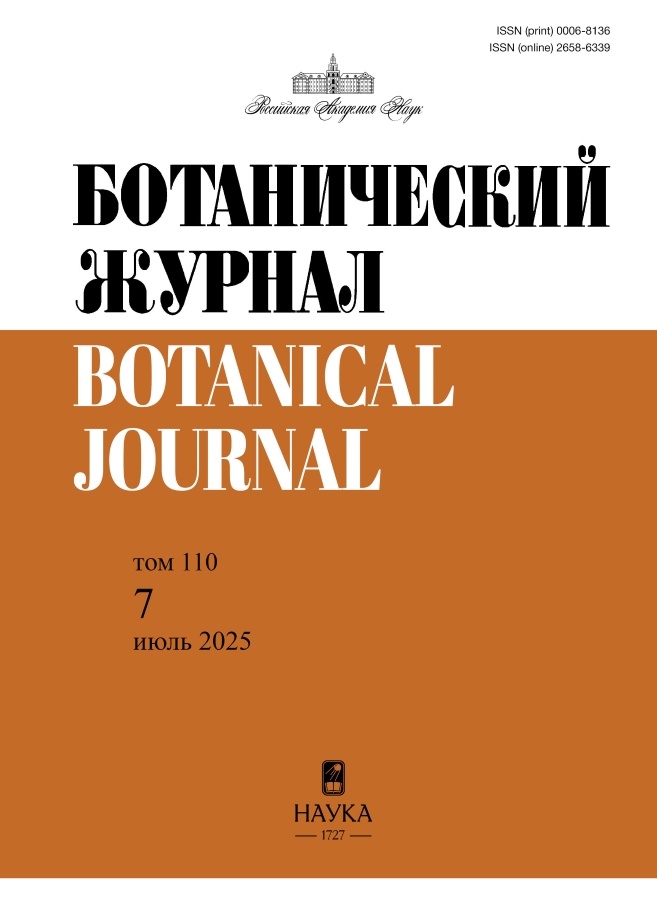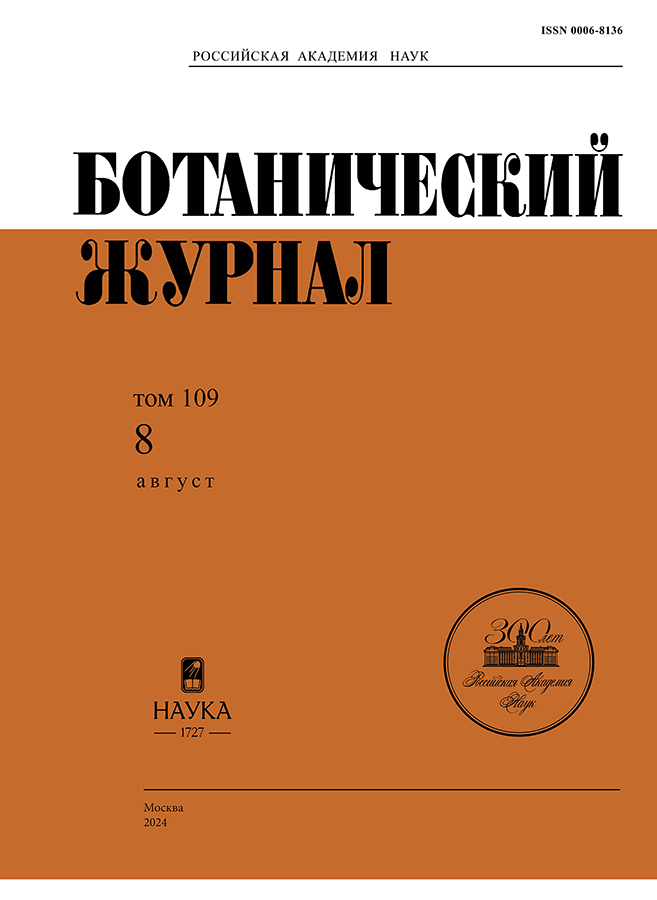Морфологическая характеристика семян четырех видов рода Cuscuta (Cuscutaceae) Амурской области
- Авторы: Лесик Е.В.1, Крещенок И.А.2, Леусова Н.Ю.3, Дарман Г.Ф.1
-
Учреждения:
- Амурский филиал Ботанического сада-института ДВО РАН
- ФГБОУ ВО “Амурская государственная медицинская академия”
- Институт геологии и природопользования ДВО РАН
- Выпуск: Том 109, № 8 (2024)
- Страницы: 780-792
- Раздел: СООБЩЕНИЯ
- URL: https://rjmseer.com/0006-8136/article/view/666514
- DOI: https://doi.org/10.31857/S0006813624080048
- EDN: https://elibrary.ru/PBISDU
- ID: 666514
Цитировать
Полный текст
Аннотация
Род Cuscuta представляет собой одну из сложных таксономических групп цветковых растений. В настоящей работе приведены результаты исследований морфологии семян и скульптуры семенной кожуры у видов Cuscuta campestris Yanck., C. tinei Inzenga, C. japonica Choisy, C. europaea L., встречающихся в Амурской области. Изучение внешнего строения семян показало, что цвет, форма, признаки поверхности семени и форма рубчика видоспецифичны. Рубчик семени у C. japonica, C. campestris, C. europaea хорошо заметен, а у С. tinei слабозаметный, слегка вдавленный. На основании морфологических признаков составлен краткий ключ для идентификации видовой принадлежности семян изученных представителей рода Cuscuta.
Ключевые слова
Об авторах
Е. В. Лесик
Амурский филиал Ботанического сада-института ДВО РАН
Автор, ответственный за переписку.
Email: stork-e@yandex.ru
Россия, Игнатьевское шоссе, 2-й км, Благовещенск, 675000
И. А. Крещенок
ФГБОУ ВО “Амурская государственная медицинская академия”
Email: ikreshhenok@yandex.ru
Россия, ул. Горького, 95, Благовещенск, 675000
Н. Ю. Леусова
Институт геологии и природопользования ДВО РАН
Email: leusova@mail.ru
Россия, пер. Релочный, 1, Благовещенск, 675000
Г. Ф. Дарман
Амурский филиал Ботанического сада-института ДВО РАН
Email: gfdarman@yandex.ru
Россия, Игнатьевское шоссе, 2-й км, Благовещенск, 675000
Список литературы
- Аистова Е.В., Леусова Н.Ю. 2015. Род Cuscuta L. в Восточной Азии. – Turczaninowia. 18(2): 111–128.
- An update of the Angiosperm Phylogeny Group classification for the orders and families of flowering plants: APG II. The angiosperm phylogeny group. 2003. – Bot. J. Linn. Soc. 141: 399–436.
- An update of the Angiosperm Phylogeny Group classification for the orders and families of flowering plants: APG III. The angiosperm phylogeny group. 2009. – Bot. J. Linn. Soc. 161: 105–121.
- Айрапетян А.М. 2010. Морфология пыльцы рода Cuscuta L. – Ученые записки Ереванского гос. ун-та. Серия химия и биология. 1: 42–49.
- Баркалов В.Ю. 1995. Семейство Повиликовые – Cuscutaceae Dum. Сосудистые растения советского Дальнего Востока. Т. 7. СПб. С. 279–284.
- Barthlott W. 1981. Epidermal and seed surface characters of plants: systematic applicability and some evolutionary aspects. – Nord. J. Bot. 1: 345–355.
- Bojňanský V., Fargašová A. 2007. Atlas of seeds and fruits of central and east-european flora. The Carpathian Mountains Region. Springer. 1046 р.
- Chrtek J., Osbornova J. 1991. Notes on the Synanthropic Plants of Egypt. 3. Grammica campestris and other species of family Cuscutaceae. – Folia Geobotanica et Phytotaxonomica. 26: 287 – 314.
- Costea M., Garcia M.A., Stefanovic S. 2015. A phylogenetically based infrageneric classification of the parasitic plant genus Cuscuta (Dodders, Convolvulaceae). – Systematic Botany. 40(1): 269–285 https://doi.org/10.1600/036364415X686567
- Costea M., Nesom G.L., Stefanoviс S. 2006. Taxonomy of the Cuscuta pentagona complex (Convolvulaceae) in North America. – Sida. 22(1): 151–175.
- Costea M., Tardif F.J. 2006.The biology of Canadian weeds.133. Cuscuta campestris Yuncker, C. gronovii Willd. ex Schult., C. umbrosa Beyr. ex Hook., C. epithymum (L.)L. and C. epilinum Weihe. – Canаdian Journal Plant Science. 86: 293–316.
- Costea M., Stefanović S., García M.A., De La Cruz S., Casazza M.L., Green A.J. 2016. Waterfowl endozoochory: an overlooked long-distance dispersal mode for Cuscuta (dodder). – Am. J. Bot. 103(5): 957–962. https://doi.org/10.3732/ajb.1500507
- Cronquist A. 1981. An integrated system of classification of flowering plants. New York. 262 p.
- [Danilova, Kirpichnikov] Данилова М.Ф., Кирпичников М.Э. 1985. Словарь терминов. В кн.: Сравнительная анатомия семян. Однодольные. Т. 1. Л. 317 с.
- [Dobrokhotov] Доброхотов В.Н. 1961. Семена сорных растений. Определитель (справочник). М. 464 с.
- Elsiddig M.A., Mahadi Y.M., Mohamed E.H., Alamin S.E., Alrahim A.I.A., Haroun N.E., Eltayeb A.H., Ibraheem Y.M. 2018. Genetic diversity of dodder (Cuscuta spp.) collected from Khartoum and Gezira states. – International Journal of Scientific and Research Publications. 8(12): 634–640. https://doi.org/10.29322/IJSRP.8.12.2018.p8482
- Gaertner E.E. 1950. Studies of seed germination, seed identification, and host relationships in dodders, Cuscuta spp. – Mem Cornell Univ Agri Exp Station. 294: 1–56.
- García M.A., Costea M., Kuzmina M., Stefanović S. 2014. Phylogeny, character evolution, and biogeography of Cuscuta (dodders; Convolvulaceae) inferred from coding plastid and nuclear sequences. – Am. J. Bot. 101(4): 670–690 https://doi.org/10.3732/ajb.1300449
- Hamed K.A. 2005. Pollen and seed characters of certain Cuscuta species growing in Egypt with a reference to a taxonomic treatment of the genus. – International Journal of Agriculture and Biology. 7(3): 325–332.
- Ho A., Costea M. 2018. Diversity, evolution and taxonomic significance of fruit in Cuscuta (dodder, Convolvulaceae); the evolutionary advantages of indehiscence. – Perspectives in Plant Ecology, Evolution and Systematics. 32: 1–17. https://doi.org/10.1016/j.ppees.2018.02.001
- Inkyu Park, Jun-Ho Song, Sungyu Yang, WookJin Kim, Goya Choi, Byeong Cheol Moon. 2019. Cuscuta species identification based on the morphology of reproductive organs and complete chloroplast genome sequences. – International Journal of Molecular Sciences. 20: 2726. https://doi.org/10.3390/ijms20112726
- Kanwal D., Abid R., Qaiser M. 2010. The seed atlas of Pakistan-III. Cuscutaceae. – Pakistan Journal of Botany. 42(2): 703–709. https://doi.org/10.3390/ijms20112726
- Определитель растений Приморья и Приамурья. 1966. М. –Л. 491 с.
- Комаров В.Л., Клобукова-Алисова Е.Н. 1932. Определитель растений Дальневосточного края. Т. 2. Л. C. 623–1175.
- Lyshede O.B. 1984. Seed structure and germination in Cuscuta pedicellate and C. campestris. – Nordic Journal of Botany. 4: 69–74.
- https://doi.org/10.1111/j.1756-1051.1984.tb01992.x
- Lyshede O.B. 1992. Studies on mature seeds of Cuscuta pedicellata and C. campestris by electron microscopy. – Annals of Botany. 69(4): 365–371. https://doi.org/10.1093/oxfordjournals.aob.a088353
- Маак Р.К. 1861. Путешествие по долине реки Уссури, совершенное по поручению сибирского отдела Императорского русского географического общества. Т. 1. СПб. 240 с.
- McNeal J.R., Arumugunathan K., Kuehl J.V., Boore J.L., de Pamphilis C.W. 2007. Systematics and plastid genome evolution of the cryptically photosynthetic parasitic plant genus Cuscuta (Convolvulaceae). – BMC Biology. 5: 55. https://doi.org/10.1186/1741-7007-5-55
- Nickrent D.L., Musselman L.J. 2004. Introduction to parasitic flowering plants. The plant health instructor. http://www.apsnet.org/edcenter/intropp/PathogenGroups/Pages/ParasiticPlants.aspx http://dx.doi.org/10.1094/PHI-I-2004-0330-01
- Никитин В.В. 1983. Сорные растения флоры СССР. Л. 454 с.
- Olszewski M. 2019. Diversity and Evolution of Seeds in Cuscuta (dodders, Convolvulaceae): Morphology and structure. Theses and Dissertations (Comprehensive). 111 р. https://scholars.wlu.ca/etd/2186
- Olszewski M., Dilliott M., García-Ruiz I., Bendarvandi B., Costea M. 2020. Cuscuta seeds: Diversity and evolution, value for systematics/identification and exploration of allometric relationships. – PLoS ONE. 15(6): 1–23. https://doi.org/10.1371/JOURNAL.PONE.0234627
- Плиско М.А. 2010. Семейство Cuscutaceae. Сравнительная анатомия семян. Двудольные. Lamiidae, Asteridae. Т. 7. СПб. С. 183–191.
- Reed C., Hughe R. 1977. Economically Important Foreign Weeds. Agricultural Handbook Agricultural Research Service, Animal and Plant Health Inspection Service, United States Department of Agriculture. 498: 746.
- Sarić-Krsmanović M., Vrbničanin S. 2017. Field dodder life cycle and interaction with host plants. – Pestic. Phytomed. (Belgrade). 32(2): 95–103. https://doi.org/10.2298/PIF1702095S
- Shena G., Liua N., Zhanga J., Xua Y., Baldwinc I.T., Wu J. 2020. Cuscuta australis (dodder) parasite eavesdrops on the host plants’ FT signals to flower. – PNAS. 117(37): 23125–23130. https://doi.org/10.1073/pnas.2009445117/-/DCSupplemental
- Simões A.R.G., Eserman L.A., Zuntini A.R., Chatrou L.W., Utteridge T.M.A., Maurin O., Rokni S., Roy S., Forest F., Baker W.J., Stefanovic S. 2022. A bird’s eye view ´of the systematics of Convolvulaceae: novel insights from nuclear genomic data. – Frontiers in Plant Science. 13: 889–988. https://doi.org/10.3389/fpls.2022.889988
- Stefanovic S., Krueger L., Olmstead R.G. 2002. Monophyly of the Convolvulaceae and circumscription of their major lineages based on DNA sequences of multiple chloroplast loci. – Am. J. Bot. 89(9): 1510–1522. https://doi.org/10.3732/ajb.89.9.1510
- Stefanovic S., Kuzmina M., Costea M. 2007. Delimitation of major lineages within Cuscuta subgenus Grammica (Convolvulaceae) using plastid and nuclear DNA sequences. – Am J. Bot. 94(4): 568–589.
- Stefanovic S., Olmstead R.G. 2004. Testing the Phylogenetic Position of a Parasitic Plant (Cuscuta, Convolvulaceae, Asteridae): Bayesian Inference and the Parametric Bootstrap on Data Drawn from Three Genomes. – Systematic Biology. 53(3): 384–399. https://doi.org/10.1080/10635150490445896
- Takhtajan A. 2009. Flowering Plants. Second Edition. Netherlands. 872 р.
- Тахтаджян А.Л. 1964. Основы эволюционной морфологии покрытосеменных. М.–Л. 236 с.
- Тахтаджян А.Л. 1987. Система магнолиофитов. Л. 439 с.
- Терехин Э.С. 1977. Паразитные цветковые растения: эволюция онтогенеза и образ жизни. Л. 220 с.
- Терехин Э.С., Котов В.А. 1988. Эмбриология Cuscuta japonica (Cuscutaceae). – Бот. журн. 73(2): 222–230.
- Ворошилов В.Н. 1966. Флора советского Дальнего Востока (конспект с таблицами для определения видов). М. 479 с.
- Ворошилов В.Н. 1982. Определитель растений советского Дальнего Востока. М. 672 с.
- Ворошилов В.Н. 1985. Список сосудистых растений советского Дальнего Востока. Флористические исследования в разных районах СССР. M. С. 139–200.
- Welsh M., Stefanovic S., Costea M. 2010. Pollen evolution and its taxonomic significance in Cuscuta (dodders, Convolvulaceae). – Plant Systematics and Evolution. 285: 83–101. https://doi.org/10.1007/s00606-009-0259-4
- Yuncker T.G. 1932. The genus Cuscuta. – Torrey Botanical Society. 18: 113–331.
- Zare G., Dönmez Ali.A. 2020. Cuscuta campestris Yunck. Morphology, anatomy and traditional use in Turkey. – Hacettepe University Journal of the Faculty of Pharmacy. 40(1): 1–10.
Дополнительные файлы











